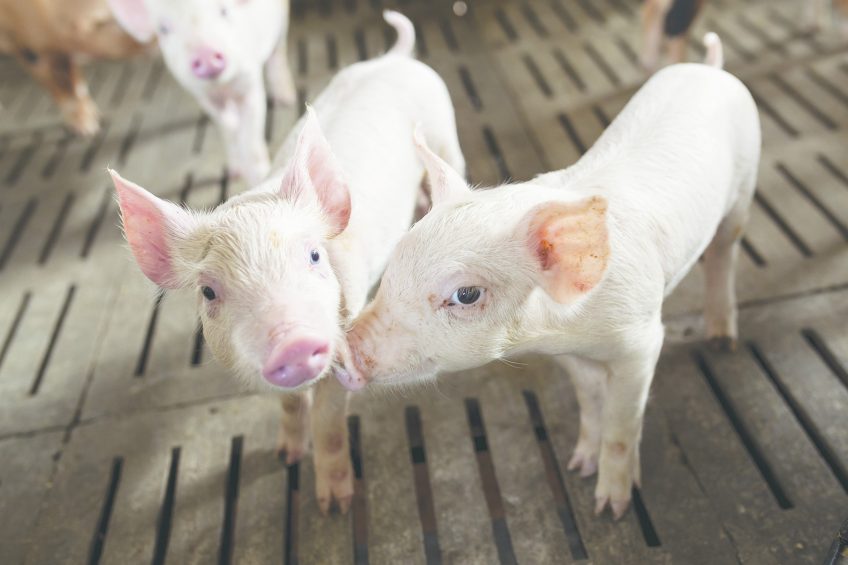Holistic approaches to gut health challenges

The early development of piglets depends on their health and nutrition, and that sets the stage for their lifetime performance. If adequate strategies are not implemented, producers will leave growth potential, and ultimately money, on the table.
Intestinal challenges are a great cause of performance losses during the post-weaning period, which will consequently translate into critical economical losses accumulated throughout the pig’s life. It is well known that antibiotics inhibit growth of certain pathogenic micro-organisms in the gut and can be used to boost pig performance. However, the demand for antibiotic-free pork and the curbing of antibiotics as growth promoters in pig production globally creates a need for holistic approaches to sustain intestinal health and thriving piglets, even in the absence of antibiotics.
In spite of the reduction of antibiotic use, there are strategies that can be used to reduce intestinal challenges that piglets encounter after weaning and maintain or even improve growth performance. A few examples of strategies to optimise gut health are stricter biosecurity initiatives, nutritional strategies like higher use of synthetic amino acids, feed supplements like chelated trace minerals, and organic acids. Trace minerals are required in very small amounts, but are indispensable to maintain piglet health. Similarly, certain organic acids can also promote piglet health by improving gut microflora.
Pathogenic micro-organisms damage the cells that line the small intestine and impair the absorption of nutrients, thus reducing key profitability indicators. If the lining is damaged, the young piglet has diminished nutrient absorption and becomes more susceptible to pathogens that may cause disease and increased mortality. Therefore, improving gut health can make piglets stronger and healthier, with increased absorption of nutrients and increased growth rates allowing for a successful lifetime growth.
Effect of chelated trace minerals
For many years, copper supplementation has been used in nursery diets to help with diarrhoea and improve growth rates. Recent studies have found that copper bound with methionine hydroxy analog (creating metal methionine hydroxy analog chelate or MMHAC) is a highly bioavailable source of chelated copper and provides superior results compared with other copper sources. A trial with nursery piglets was carried out to test the effects of different sources of copper.
Treatments were
- control diet with no copper supplementation,
- a control diet plus 160 ppm of copper sulphate,
- a control diet plus 160 ppm of tribasic copper chloride (TBCC), or
- a control diet plus 150/80 and 50 ppm of copper as MMHAC for phase 1, 2 and 3, respectively.
There was no statistical difference (P > 0.05) on bodyweight at nursery exit (day 70) for piglets fed control (29.9 kg), copper sulphate (30.61 kg), or TBCC (30.82 kg). Piglets fed diets containing copper as MMHAC (32 kg) were heavier (P < 0.01) than piglets fed other treatments, with about 1.2 kg bodyweight advantage at nursery exit.
In another trial, nursery piglets fed copper as MMHAC showed 34% less incidence of diarrhoea when compared with pigs fed an inorganic mineral premix. Similarly, a trial with 320 nursery piglets tested diets with either copper as MMHAC or copper sulphate (CuSO4) at 150 ppm. Piglets fed copper as MMHAC had 5.2% greater (P < 0.05) daily gain, and 8.2% improvement (P < 0.05) on feed efficiency compared with piglets fed CuSO4. It is also remarkable that pigs fed copper as MMHAC were 1.6 kg heavier at the end of the nursery phase when compared with pigs fed inorganic minerals, which could mean up to 4 kg at market weight or about five days less at the finishing barn, increasing pig flow and profitability. But, most interesting was the benefit of copper as MMHAC on overall health. Feeding copper as MMHAC reduced the total cost of medication by 9.3% when compared with feeding inorganic trace minerals. This diet also allowed more piglets to thrive, with 47% less (P < 0.05) runts (12.1 vs. 6.4%), and a sharp decrease (P < 0.05) in the mortality rate when compared to piglets fed CuSO4 (Figure 1).
Figure 1 – MMHAC Cu reduced mortality rate of nursery piglets.

The improvement in feed conversion, diarrhoea and growth rate, reduction in the number of runts, and the decrease in mortality shows the broad benefits feeding copper as MMHAC can exert on key challenges related to poor gut health. A healthy gut has better nutrient absorption, less digestive disorders like diarrhoea, and, because the intestinal lining cells are stronger, the animal is more protected against the entrance of pathogens through the gut.
Benefits of protected benzoic acid
Benzoic acid is an organic acid that rapidly alters the intracellular pH of intestinal bacteria by overloading its capabilities to stabilise the intracellular pH, leading to the death of bacteria. Ideally, this creates an environment that minimises the proliferation of pathogenic bacteria in the gut. Despite being commonly used as a feed supplement to promote gut health, benzoic acid is generally inactivated before reaching the hindgut, where it is most needed. However, when protected in a fat matrix, benzoic acid can be slowly released throughout the intestinal tract where the pathogenic bacteria cause the most damage. In the UK, a trial was conducted with 96 nursery pigs. Piglets were fed diets containing either protected benzoic acid (PBA; 2.5 kg/ton) or a control diet containing benzoic acid 5 kg/ton. Piglets fed diets containing PBA had 60% fewer piglets treated for diarrhoea (Figure 2) and had an increase (P < 0.01) of 3% in growth rate compared with piglets fed control diets. Feeding PBA resulted in better growth rates and less diarrhoea incidence compared to piglets fed diets containing benzoic acid.
Figure 2 – Pigs fed PBA had reduced scouring compared to control.

In summary, several challenges related to poor gut health can be addressed with the supplementation of copper as MMHAC (Mintrex Cu chelated trace mineral, Novus International) and PBA (Provenia feed supplement, Novus International). Feeding copper as MMHAC can help piglets to thrive, optimise feed conversion, growth rates, and minimise diarrhoea, runts, and mortality. Similarly, feeding PBA can support better gut microflora, minimise diarrhoea and optimise growth rates. These nutritional tools can help piglets get stronger and healthier, even in reduced antibiotic scenarios.











